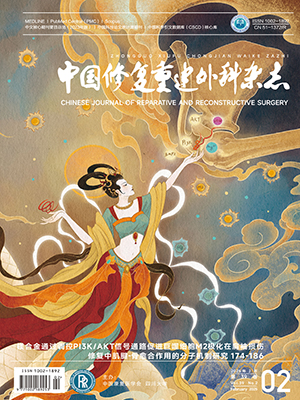| 1. |
Kaushik AP, Das A, Cui Q. Osteonecrosis of the femoral head: an update in year 2012. World J Orthop, 2012, 3(5): 49-57.
|
| 2. |
Huang Z, Cheng C, Cao B, et al. Icariin protects against glucocorticoid-induced osteonecrosis of the femoral head in rats. Cell Physiol Biochem, 2018, 47(2): 694-706.
|
| 3. |
傅维民, 刘保一, 王本杰, 等. 激素性股骨头坏死的保髋治疗策略及疗效. 中华骨科杂志, 2019, 39(23): 1424-1431.
|
| 4. |
Li J, Li ZL, Zhang H, et al. Long-term outcome of multiple small-diameter drilling decompression combined with hip arthroscopy versus drilling alone for early avascular necrosis of the femoral head. Chin Med J (Engl), 2017, 130(12): 1435-1440.
|
| 5. |
Luo P, Gao F, Han J, et al. The role of autophagy in steroid necrosis of the femoral head: A comprehensive research review. Int Orthop, 2018, 42(7): 1747-1753.
|
| 6. |
Kuroda Y, Matsuda S, Akiyama H. Joint-preserving regenerative therapy for patients with early-stage osteonecrosis of the femoral head. Inflamm Regen, 2016, 36: 4.
|
| 7. |
Fu Q, Tang NN, Zhang Q, et al. Preclinical study of cell therapy for osteonecrosis of the femoral head with allogenic peripheral blood-derived mesenchymal stem cells. Yonsei Med J, 2016, 57(4): 1006-1015.
|
| 8. |
Zhang Y, Wang W, Xie Y, et al. Optimization of microencapsulated recombinant cho cell growth, endostatin production, and stability of microcapsule in vivo. J Biomed Mater Res B Appl Biomater, 2008, 84(1): 79-88.
|
| 9. |
Ding HF, Liu R, Li BG, et al. Biologic effect and immunoisolating behavior of bmp-2 gene-transfected bone marrow-derived mesenchymal stem cells in apa microcapsules. Biochem Biophys Res Commun, 2007, 362(4): 923-927.
|
| 10. |
Paek HJ, Campaner AB, Kim JL, et al. Microencapsulated cells genetically modified to overexpress human transforming growth factor-beta1: viability and functionality in allogeneic and xenogeneic implant models. Tissue Eng, 2006, 12(7): 1733-1739.
|
| 11. |
You W, Fan L, Duan D, et al. Foxc2 over-expression in bone marrow mesenchymal stem cells stimulates osteogenic differentiation and inhibits adipogenic differentiation. Mol Cell Biochem, 2014, 386(1-2): 125-134.
|
| 12. |
Leslie SK, Kinney RC, Schwartz Z, et al. Microencapsulation of stem cells for therapy. Methods Mol Biol, 2017, 1479: 251-259.
|
| 13. |
Asada T, Kushida T, Umeda M, et al. Prevention of corticosteroid-induced osteonecrosis in rabbits by intra-bone marrow injection of autologous bone marrow cells. Rheumatology (Oxford), 2008, 47(5): 591-596.
|
| 14. |
Caldarelli I, Speranza MC, Bencivenga D, et al. Resveratrol mimics insulin activity in the adipogenic commitment of human bone marrow mesenchymal stromal cells. Int J Biochem Cell Biol, 2015, 60: 60-72.
|
| 15. |
Gangji V, De Maertelaer V, Hauzeur JP. Autologous bone marrow cell implantation in the treatment of non-traumatic osteonecrosis of the femoral head: five year follow-up of a prospective controlled study. Bone, 2011, 49(5): 1005-1009.
|
| 16. |
Zhao D, Cui D, Wang B, et al. Treatment of early stage osteonecrosis of the femoral head with autologous implantation of bone marrow-derived and cultured mesenchymal stem cells. Bone, 2012, 50(1): 325-330.
|
| 17. |
Hernigou P, Flouzat-Lachaniette CH, Delambre J, et al. Osteonecrosis repair with bone marrow cell therapies: state of the clinical art. Bone, 2015, 70: 102-109.
|
| 18. |
Wada Y, Kataoka H, Yokose S, et al. Changes in osteoblast phenotype during differentiation of enzymatically isolated rat calvaria cells. Bone, 1998, 22(5): 479-485.
|
| 19. |
Babister JC, Tare RS, Green DW, et al. Genetic manipulation of human mesenchymal progenitors to promote chondrogenesis using “bead-in-bead” polysaccharide capsules. Biomaterials, 2008, 29(1): 58-65.
|
| 20. |
Davis KE, Moldes M, Farmer SR. The forkhead transcription factor FoxC2 inhibits white adipocyte differentiation. J Biol Chem, 2004, 279(41): 42453-42461.
|
| 21. |
Hernández RM, Orive G, Murua A, et al. Microcapsules and microcarriers for in situ cell delivery. Adv Drug Deliv Rev, 2010, 62(7-8): 711-730.
|
| 22. |
Sobajima S, Vadala G, Shimer A, et al. Feasibility of a stem cell therapy for intervertebral disc degeneration. Spine J, 2008, 8(6): 888-896.
|




